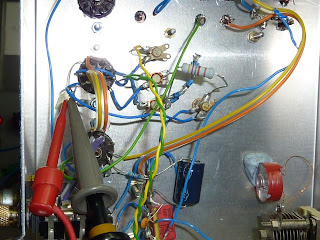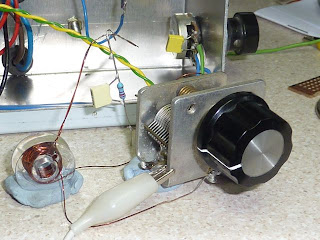The schematic (modified from the original on Harry, sm0vpo's site is shown below...

Like Harry, I used Zener Diodes to derive the stabilized voltage for the Hartley oscillator (although I did find a couple of suitable voltage stabiliser valves (CV287) whilst sorting through a box of valves this morning).
The underside of the local oscillator circuit is seen below...

It worked first time - but it now works a whole lot better after I learned something really significant...
Whilst sniffing around in that box of valves mentioned above, I was adding to my catalogue of valves "in stock", in which I like to include links to a data sheet. Whilst doing that, I noticed something I had never realized before.
The ECC81 used in the local oscillator is also widely know by the equivalent name 12AT7 (as mentioned in describing the BFO). What I never twigged before is the obvious fact that the valve should use a 12V heater supply (obvious because I knew all this from the 6SK7s etc used in my Paraset - I was considering replacement with 12SK7s to make battery operation easier). Accordingly, I had wired up the heaters for the two 12AT7s in this project for only 1/2 the rated heater voltage - amazing that they still worked at all (and another possible explanation for the fun and games I had with the BFO, as described here.)
The clever thing is this - the 12AT7 heater is "centre-tapped" so it can be powered from 6.3 V, if wired appropriately.
There really is no excuse for my ignorance - apart from the clue being very much in the name "12AT7", it is there as bold as brass in the data sheet...

Note to self (and any others who happen to be reading): this is also true for the double triodes ECC83 / 12AX7 and ECC82 / 12AU7, widely used in audio frequency gear.
Now that the heaters are running at full tilt (and glowing in a wholly more satisfactory manner) the oscillator runs fine...

I'm hoping to give this receiver 3 bands - but mostly I'm interested in the 80m amateur band, so here it is running at an appropriate frequency...

Readers won't be surprised to hear that my coils were wound on the sewing machine bobbins I've used previously...

... you can see the coil at bottom left. You can also see that I only have a single gang capacitor - which is going to be a problem (I need a twin-gang device; one for tuning the LO and one for tuning the resonant circuit at the input). That will have to be dealt with in the future - for now the carol service from from King's has just kicked off...
..../.-/.--./.--./-.-- -.-./..../.-./../.../-/--/.-/...
...-.- de m0xpd

No comments:
Post a Comment